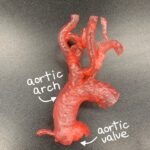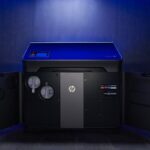

Infertility can be a heartbreaking condition for people who desperately want children, but there’s hope. A team of researchers from Northwestern University‘s Feinberg School of Medicine and McCormick School of Engineering today published a study documenting their research into 3D printed prosthetic ovaries. The team was led by Teresa Woodruff, reproductive scientist and director of the Women’s Health Research Institute at Feinberg, and Ramille Shah, assistant professor of materials science and engineering at McCormick and of surgery at Feinberg. Shah has been involved with several other bioprinting breakthroughs, including a recent study on 3D printed hyperelastic bone. “Breakthrough” is the only way to describe this most recent study, as the team not only 3D printed ovaries, but implanted one of them in a mouse that then gave birth to healthy babies.
According to Shah, the key to the success of the project was the hydrogel used to create the scaffold for the 3D printed organ. It was a challenge to find the right material – the researchers had to create something that was rigid enough to hold its form during implantation but porous enough to interact naturally with the mouse’s system once it was implanted. The solution came in the form of a gelatin seeded with immature eggs.
“Most hydrogels are very weak, since they’re made up of mostly water, and will often collapse on themselves,” Shah said. “But we found a gelatin temperature that allows it to be self-supporting, not collapse, and lead to building multiple layers. No one else has been able to print gelatin with such well-defined and self-supported geometry.”
That geometry was critical to the survival of the ovarian follicles, which are hormone-producing cells that surround an egg. The scaffold supported both the immature eggs and the follicles, while allowing enough space for the eggs to mature and for the ovary to form blood vessels, letting hormones circulate and trigger lactation after birth.
“This is the first study that demonstrates that scaffold architecture makes a difference in follicle survival,” Shah said. “We wouldn’t be able to do that if we didn’t use a 3-D printer platform.”

The study was undertaken in hopes of one day restoring fertility to female cancer patients whose treatment, whether in childhood or adulthood, had rendered them infertile or with lowered fertility. The natural ovary was removed from a mouse and replaced with the 3D printed one. Once it was implanted, it was able to ovulate like a biological ovary, and once the mouse was mated, she became pregnant and gave birth to healthy baby mice, which are called pups. The mother was even able to lactate and nurse her babies.
“What happens with some of our cancer patients is that their ovaries don’t function at a high enough level and they need to use hormone replacement therapies in order to trigger puberty,” said Monica Laronda, co-lead author of the study. “The purpose of this scaffold is to recapitulate how an ovary would function. We’re thinking big picture, meaning every stage of the girl’s life, so puberty through adulthood to a natural menopause.”
The fact that such a complex organ can be replaced by a 3D printed one has big implications for the future of regenerative medicine, as well, taking us another step closer to being able to 3D print functional organs and transplant them into humans.
“This research shows these bioprosthetic ovaries have long-term, durable function,” said Woodruff. “Using bioengineering, instead of transplanting from a cadaver, to create organ structures that function and restore the health of that tissue for that person, is the holy grail of bioengineering for regenerative medicine.”
The research has been published in a paper entitled “A bioprosthetic ovary created using 3D printed microporous scaffolds restores ovarian function in sterilized mice,” which you can read here. Authors include Monica M. Laronda, Alexandra L. Rutz, Shuo Xiao, Kelly A. Whelan, Francesca E. Duncan, Eric W. Roth, Teresa K. Woodruff and Ramille N. Shah. Discuss in the 3D Printed Ovary forum at 3DPB.com.
[Source: Northwestern University]
When it comes to 3D real estate visualization in the USA, our service provides the perfect solution for bringing property listings to life. Through our platform, you can easily access cutting-edge 3D renderings that showcase your real estate projects in a way that attracts potential buyers and investors. Whether it's residential, commercial, or mixed-use properties, our team of experts uses advanced technology to create immersive visualizations that highlight the best features of your property, making it easier for clients to imagine the space as their own.
Through our website, you can quickly get high-quality 3D real estate visualizations that are tailored to your specific needs. With our help, you'll stand out in the competitive real estate market by offering potential buyers a realistic, interactive view of your property. Our efficient process ensures a fast turnaround time, while our attention to detail guarantees that every aspect of the property is represented accurately, giving you a powerful marketing tool to promote your real estate listings.






